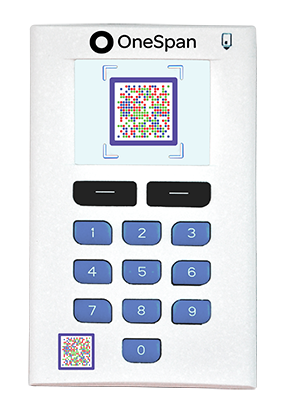HIGHLIGHTS
Digipass 882 is an advanced transaction signing device that combines a secure smart card reader with patented Cronto technology that leverages the latest in visual cryptogram security. It is designed to help financial institutions protect online banking applications from sophisticated cyber threats while delivering outstanding user convenience
Strong security
Digipass 882’s uniquely integrated card reader and innovative Cronto technology delivers the ultimate protection against sophisticated fraud schemes such as phishing, social engineering, banking Trojans, man-in-the-middle (MITM) and manin-the-browser (MITB) attacks.
Exceptional user convenience
Visual transaction signing enhances convenience for users by dramatically simplifying the user’s interaction. All transaction data is captured by scanning a secure Cronto image, so there is no need for users to manually type in transaction details on the device. A full color display highlights important transaction data.
Quick and clear transaction review
Critical transaction information, including payment details, is encrypted and automatically presented on the Digipass 882 color display for visual review and verification, ensuring that the transaction details are accurate.
Easy to deploy
Digipass 882 is ideally suited for large deployments requiring the strongest security. Additionally, it requires no formal activation process and the optical interface works without any software or driver to be installed on the end user’s PC.
Customizable design
Digipass 882 is completely customizable, and can be enhanced with your organization’s logo, branding, custom colors and keypad.
How it works
Digipass 822 provides users the following simple, convenient and secure experience:
- The user enteres transaction details into online banking application.
- Details of the transaction are encrypted and presented via a Cronto image within the application on the user’s computer, mobile phone or tablet.
- The user inserts a smart card and enters PIN on the key pad.
- After PIN verification, the user “scans” the image with the Digipass 882 built-in camera.
- Digipass 882 instantly decrypts the transaction details and presents this information on the color display for user verification.
- Once verified by the user, a signature is generated on the Digipass 882, which the user enters into online banking application in order to confirm the transaction.

PRODUCT SPECIFICATIONS
OneSpan reader
Unconnected smart card reader with display and camera
User interface
1,77 in. TFT color ( 128*160 dots)
Smart Card interface
ISO7816, T=0, T=1
Frequency up to 4 Mhz
Supports ISO 7816 Class A
10,000 smart card insertions
Embossed smart card supported
Size L*W*T
99 * 60 * 18,6 mm
Weight
Without batteries <53 g. - with batteries <88g
Keypad
Rubber keypad (10 numerics + 2 function keys) to over 100,000 key press
Replaceable Battery
3 AAA replaceable batteries /expected lifetime 3 years
Standards
Mastercard CAP
VISA dynamic passcode authentication
German sm@rt TAN
EMV2000 LEVEL 1
Customization
Bank’s logo can be printed on the reader. Color of the casing and keyboard can also be customized.
COMPLIANCE SPECIFICATIONS
Short Term Storage Temperature*
-10 °C to 50 °C; 90 %RH non-condensing
IEC 60068-2-78 (Damp heat)
IEC 60068-2-1 (Cold)
Operating temperature
0 °C to 45 °C; 85 %RH non-condensing
IEC 60068-2-78 (Damp heat)
IEC 60068-2-1 (Cold)
Vibration
10 to 75 Hz; 10 m/s2 IEC 60068-2-6
Drop
1 meter IEC 60068-2-31
Emission
EN 55022
Immunity
4 kV contact discharges
8 kV air discharges
3 V/m from 80 to 1000 MHz
EN 61000-4-2 and EN 61000-4-3
Compliance to European directives (CE marking)
2004/108/EC (EMC directives)
2011/65/EC (RoHS directive)
2012/19/EC (WEEE directive)
* Batteries should be stored at temperatures between 50°F (10°C) and 77°F (25°C), with relative humidity not exceeding 65 percent. Refrigeration of alkaline batteries is not necessary because of their very good capacity retention. Excessive temperature cycling and storage at temperatures greater then 77°F (25°C) should be avoided to maximize shelf life.